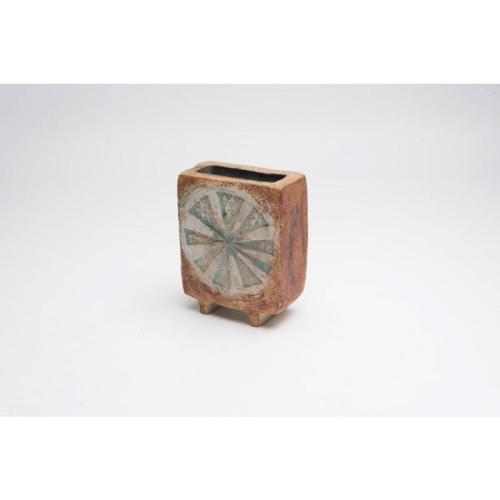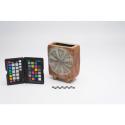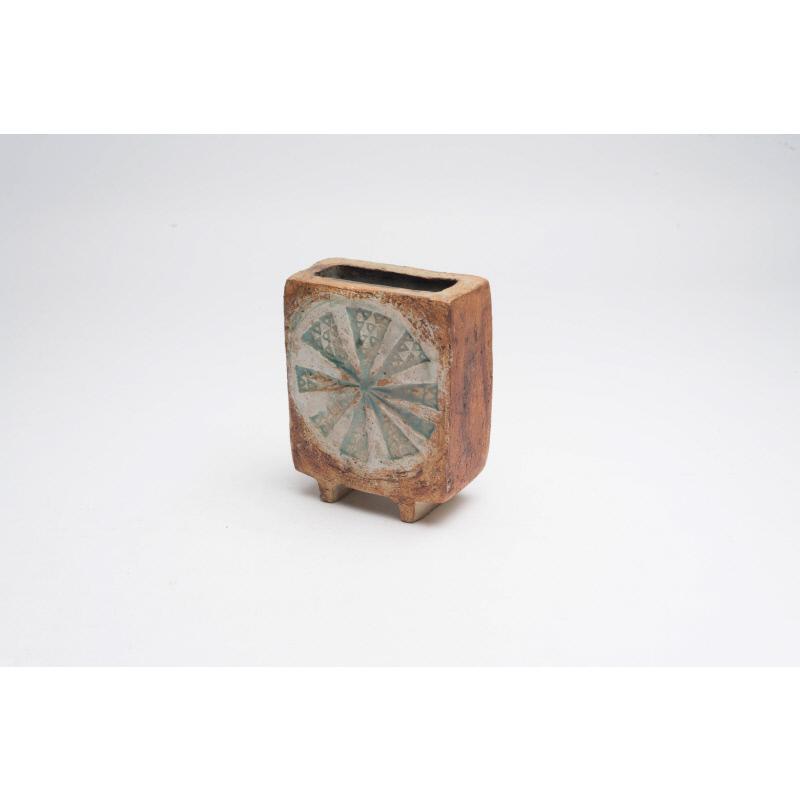Vase
Classification(s):
Pottery
Date: c.1951 - 1976
Maker: Alan Wallwork (born 1931)
Dimensions:
176 × 129 mm (17.6 × 12.9 cm)
Medium: Stoneware
Object number: P1033A
See Also
DescriptionGlazed stoneware ceramic vase by Alan Wallwork. The vase is rectangular in shape and rests on 2 parallel feet. There is incised detailing to the front and reverse. The design resembles wind turbine blades, made up of smaller triangle shapes.
A potter’s mark "W" is incised to the base.
A potter’s mark "W" is incised to the base.
ProvenanceThis object was originally acquired for the Inner London Education Authority’s (ILEA) ‘Circulating Design Scheme’ collection.
The collection was instigated by the London Country Council (later the Greater London Council) and the Council of Industrial Design (COID). The collection’s original purpose was concerned with the teaching and dissemination of modern, ‘good design’.
The collection was established in 1951/52 as the ‘Experiment in Design Appreciation’, later renamed the ‘Circulating Design Scheme’.
The Circulating Design Scheme lent boxed showcases to London schools. The showcases contained handling objects, material samples and interpretation on a specific subject.
COID withdrew its involvement in the Scheme in 1957. After which time, it was managed exclusively by the London County Council from 1957-1963.
After the administrative restructuring of London authorities, the Scheme was jointly managed by the Greater London Council and the Inner London Education Authority (ILEA) from 1963 – 1976.
The Scheme was operational until 1976 when the collections were withdrawn from circulation. ILEA was abolished in the late 1980s and the collection was donated to Camberwell College of Arts in 1989/90.
ILEA was responsible for secondary and tertiary education in the inner London boroughs, this included Camberwell.
The collection was instigated by the London Country Council (later the Greater London Council) and the Council of Industrial Design (COID). The collection’s original purpose was concerned with the teaching and dissemination of modern, ‘good design’.
The collection was established in 1951/52 as the ‘Experiment in Design Appreciation’, later renamed the ‘Circulating Design Scheme’.
The Circulating Design Scheme lent boxed showcases to London schools. The showcases contained handling objects, material samples and interpretation on a specific subject.
COID withdrew its involvement in the Scheme in 1957. After which time, it was managed exclusively by the London County Council from 1957-1963.
After the administrative restructuring of London authorities, the Scheme was jointly managed by the Greater London Council and the Inner London Education Authority (ILEA) from 1963 – 1976.
The Scheme was operational until 1976 when the collections were withdrawn from circulation. ILEA was abolished in the late 1980s and the collection was donated to Camberwell College of Arts in 1989/90.
ILEA was responsible for secondary and tertiary education in the inner London boroughs, this included Camberwell.
NotesAlan Wallwork studied pottery at Goldsmith’s College. In 1958 he opened a studio and gallery in Forest Hill, South London. Wallwork produced domestic wares and hand-built pieces. He experimented with tin glazing, sgraffito decoration and creating textures by incising and stamping. Fellow potter Bernard Rooke shared a workspace with Wallwork at this time. Alan’s work - particularly his tiles - was commercially successful; the Design Centre accepted his designs, and they were retailed through the Heal's department store. The Craft Potters Association elected him as a council member.







